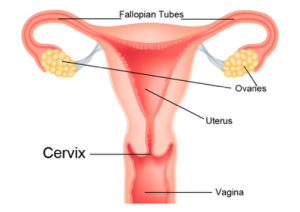Cervical cancer is one of the commonest cancers that occur in women. It starts in the lower part of the uterus called the cervix. It is a highly preventable cancer as most of the cases occur due to a viral infection with HPV – human papilloma virus. This infection is spread by sexual contact and mostly gets cleared out by the body. But sometimes this virus persists in the body and causes slow changes that lead to cervical cancer. Therefore, preventing HPV infection significantly lowers the risk of getting cervical cancer in women.
Symptoms of cervical cancer
Cervical cancer is a slow growing cancer and can remain without any symptoms for a long time. That is the reason why screening with the pap test is very important. It can detect early cancer and even the stages before cancer that are curable. Common symptoms include irregular bleeding, bleeding after sex, spotting in between menses, pelvic pain, pain with urination, and an abnormal discharge.
What is a pap test?
Cervical cancer and HPV infection can be detected using a screening test called the pap smear. The pap test has been one of the biggest accomplishments in public health because it has reduced the incidence of (and death from) cervical cancer tremendously in the last several decades. This test collects a sample of cells from the cervix to make slides and test for abnormal changes in cells that lead to cancer. It can detect early cancer too. In both instances, treatment can be initiated early with complete cure.
A pap test can be done with or without the HPV test. It can detect HPV infection before any changes can be seen in the cervical cells. Treatment at this stage helps to prevent further changes that lead to cancer. Therefore, pap smear is highly recommended for all women on a regular basis between the ages of 21 and 65 all over the world.
When should a pap test be done?
A pap test is recommended based on age of the woman (see below). Younger women need not get the HPV test as most often these get cleared out by the body. However, if they can afford it, they can get the HPV test with the pap smear. Older women >30 years of age should preferably do both together.
|
Age |
Recommendation |
|
<21 |
No pap test |
|
21-29 |
Pap smear every 3 years* |
|
30-65 |
Pap smear with HPV test every 5 years* OR Pap smear without HPV every 3 years* |
|
>65 |
No pap test |
| After hysterectomy |
No pap test |
* If abnormal report follow-up with specialist for more tests highly recommended
How is a pap test done?
A pap test can be done by any doctor but is mostly done by a gynecologist or primary care physicians. The patient has to lie on the back on the exam table with the legs up in the stirrups as during the delivery of a baby. The doctor uses a speculum and light to look inside the vagina. The cervix tip is visible and a special brush is used to scrape off a few cells from the tip as well as a little bit inside the cervical canal and transferred on to a slide or a preservative liquid. It is not painful though there may be some discomfort. Normally there should not be any bleeding after the test but rarely a little spotting is normal. Anything more than that should be reported to the doctor.
Conclusion
Cervical cancer is common in India and largely preventable and curable by screening with a pap smear test. All women between the ages on 21 and 65 should get regular pap tests for screening. Pap tests should be easily available in hospitals and clinics. In the western world, this test is an integral part of primary care and a majority of women get screened as part of their preventive health checkup. In India, women should be proactive in asking their doctors about getting a pap test done as usually no screening guidelines are followed in the absence of a cohesive primary care system.


Recent Comments